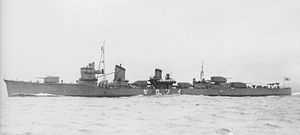Japanese destroyer Isokaze (1939)
 Isokaze underway on November 22, 1940. | |
| Career | |
|---|---|
| Name: | Isokaze |
| Ordered: | 1937 |
| Laid down: | 25 November 1938 |
| Launched: | 19 June 1939 |
| Commissioned: | 30 November 1940 |
| Struck: | 25 May 1945 |
| Fate: | Scuttled, 7 April 1945 |
| General characteristics | |
| Class and type: | Kagero-class destroyer |
| Displacement: | 2,490 long tons (2,530 t) |
| Length: | 118.5 m (388 ft 9 in) |
| Beam: | 10.8 m (35 ft 5 in) |
| Draft: | 3.8 m (12 ft 6 in) |
| Speed: | 35 knots (40 mph; 65 km/h) |
| Complement: | 239 |
| Armament: | • 6 × 5 in (130 mm)/50 caliber DP guns • up to 28 × 25 mm AA guns • up to 4 × 13 mm AA guns • 8 × 24 in (610 mm) torpedo tubes • 36 depth charges |
Isokaze (磯風, "Wind on the Beach") was a Kagero-class destroyer of the Imperial Japanese Navy. It is the second ship to carry the name after the lead ship from Isokaze-class destroyer.
On 7 April 1945, Isokaze escorted the battleship Yamato from the Inland Sea on her Operation Ten-Go attack on the Allied forces on Okinawa. She was struck by aircraft of Task Force 58 and scuttled with gunfire 150 miles (280 km) southwest of Nagasaki (30°28′N 128°55′E / 30.46°N 128.92°E). Of those on board, 20 were killed and rest were rescued by other ships. Yamato's other escorts, including Hamakaze, Asashimo and Yamato herself, were sunk afterwards, Asashimo losing all hands during the encounter.
See also
- List of World War II ships
- List of ships of the Japanese Navy
External links
| ||||||||||||||||||